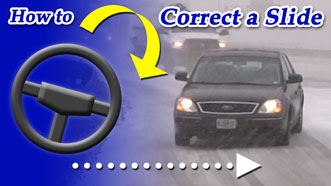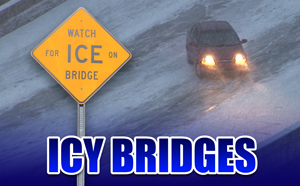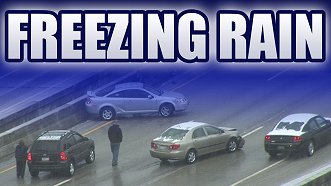Road Icing Myths and Frequently Asked Questions
This Q&A covers general road icing issues as well as some questions regarding implementing a National Weather Service-based road ice warning product.
ALSO SEE: The Top 7 Icy Road Myths
Aren't icy roads a visually obvious hazard that drivers have no excuse ignoring?
A white, snowpacked road is not the picture of the typical high-fatality road icing hazard. Indeed, accident rates are lower when roads are completely covered in snow. In contrast, some of the worst icy road accident outbreaks occur with freezing precipitation (ZR and FZDZ), which creates road ice that is not visually distinguishable from wet roads. Traffic can pack/refreeze icing from light snow to create a very slick yet more subtle-appearing layer of ice. Furthermore, icing of these types tends to be isolated and patchy, resulting in a hazard that a driver may not encounter until they are several miles into their journey. This is especially true of bridge icing, which a driver may not encounter after many miles of driving on wet or dry pavement. SEE ALSO: Article: The road ice hazard defined Aren't all road ice crashes caused by careless drivers?
While it is true that some accidents on icy roads are the result of drivers not exercising due care in the face of a visually apparent hazard, the actual data shows that many cannot be classified as such. Many accidents result from drivers who were not operating their vehicles in a careless manner, but had no advance warning of an icing hazard being present before they encountered it. This is especially true for bridge icing, which will have few visual indicators until the driver is about to cross the bridge. There is also currently not a high level of awareness of the degree of the road ice threat to life and property, which influences driver response. It is viewed as, and often portrayed as by official sources and the media, a 'travel nusiance' that is simply an inconvenience for the motorist.
Aren't icy road crashes caused by driving too fast for conditions, not ice and snow?
This one is a bit of a 'trick question'. Yes, driving too fast for conditions is part of the chain of events leading to loss of control. But calling it the cause, and leaving it at that, doesn't move us toward a solution. A deeper question needs to be asked: why are the drivers going too fast for conditions on ice or snow? The answers to that question can vary. Sometimes it's the driver's lack of awareness of the dangers ahead, such as is the case with bridge icing, the invisible icing from freezing rain and the subtle icing from light snow. Sometimes the driver is misinformed about the capabilities of their vehicle, such as you see when television ads show new cars racing through snow at high speed.
It's true that there are a few drivers that are going too fast due to simple carelessness and even recklessness (IE, the 'idiot driver' stereotype). But the data does not suggest that to be a factor in the majority of accident cases. The data suggests people driving normally and responsibly are caught by surprise when they lose control and crash at high speed. Remember, we're not talking about "obviously icy" snowpacked roads during big storms. The true road ice hazard is subtle and intermittent icing due to light winter precipitation, events that suffer from a lack of highly visual cues and public awareness. It is these conditions that cause the biggest percentage of deaths and injuries.
Attributing the root cause of road ice crashes to people driving too fast is similar to saying that plane crashes are caused by pilots failing to keep their aircraft in the air. We won't begin to have an impact on reducing accidents until we dig deeper than the status quo, finding the changeable root causes of why so many drivers are going too fast when they crash on icy roads. When we equip people with knowledge about the hazard in concert with a notification/warning when it is present, only then can we hope to see a reduction in accident rates. I have a lot of experience with winter driving, so I should be OK.
The stats show that no one has the skill to drive at highway speeds on icy roads.
A factor in many of the serious and fatal crashes is overconfidence in one's abilities and/or equipment (traction control, antilock brakes, stability control, good tires). Some feel that they have sufficient experience in winter driving, and can therefore continue normally (at or above the speed limit). But a fishtail on ice that occurs at highway speeds is usually unrecoverable by even the most quick-witted and experienced drivers. Practicing slow-speed slides in parking lots is useless for what happens to a vehicle at highway speed. A person who enters a high-speed slide will quickly learn that it is something they can't handle - but all too late. What is a safe speed for driving on ice and snow?
I am not aware of any official recommendations for speeds on icy roads. However, based on my many years of driving and shooting footage in all types of winter weather conditions, I can offer my own suggestions. For a straight, level interstate, 35mph to 40mph is the maximum speed I feel comfortable with when snow is covering the road. However, certain spots such as sharp curves, interchanges, merging traffic zones, steep hills, accident sites and construction zones may require an even slower speed. Remember to keep a wide distance between other cars on the road in case you need to stop quickly.
For black ice, no speeds are safe. You can lose control on black ice at 10mph, particularly if there is any banking or slope to the roadway. If freezing rain is in the forecast, you're better off postponing travel until it is over with. As you can see in the statistical data, freezing rain and the resulting black ice is extremely deadly - it kills more people than tornadoes, hurricanes, lightning and floods!
Don't heat waves hold the title for weather's most deadly hazard?
It is true that excessive heat claims more lives annually in the USA than winter weather risks (including icy roads). However, the majority of heat-related deaths involve the elderly and/or individuals in poor health, and more specifically those in that category who do not have adequate shelter from the elements (namely air conditioning). In other words, heat waves tend to threaten a very specific demographic of the population - those without proper shelter whos physical condition makes them more susceptible to the effects of temperature extremes.
By contrast, icy roads are the greatest weather-related hazard to the average person. Unlike heat waves, icy roads threaten everyone who travels in a motor vehicle: healthy or sick, young and old, men and women, teenagers, children, infants - people of all ages and from all walks of life. No other weather hazard poses such a broad threat for each and every person in this country. Will good tires make me safer on icy roads?
Having the right type of tires on your vehicle and keeping them in good shape are very important for general winter driving. However, while good tires can sometimes help you move on icy roads, they don't help you stop and they won't keep you from losing control at high speeds. A vehicle with good winter tires will have an edge in safety on snow-packed roads, but once conditions become icy, tire quality, style or brand doesn't matter!
Having your tires in good condition and of the proper type will always be a beneficial thing in all driving conditions. But just as with other vehicle safety features like ABS, ESC and traction control, tire brand and type won't help you stop on an icy hill or prevent you from spinning out on an icy interstate.
In essence, good tires are always a great idea - but they should not lessen your level of care in driving on an icy road or when icy conditions are threatening. Isn't ice on roadways an ancillary (secondary) cause of crashes due to driver error?
Road ice from freezing precipitation is not an ancillary cause of crashes, it is the sole factor in a large percentage of accidents during light snow and freezing precipitation. With freezing precipitation, in addition to being invisible to motorists, this type of ice physically separates the vehicle tires from the road, causing loss of control without any abnormal behavior from the driver. The result of a vehicle encountering black ice is no different than if it had been blown off the road by a tornado, in that both are 100 percent a result of external weather-related forces that are of no fault of the driver.
To be sure, some drivers are to blame for crashes by not paying attention to conditions nor heeding visual warnings - but many are not, and it's not fair to blame all drivers for a weather hazard they cannot see before it is too late. Will a road ice warning product add additional expense and burden to the duties of the NWS?
The suggested changes involve simply rewording, renaming and reclassifying existing products that are already handled by the NWS. For instance, this article recommends issuing a "Road Ice Warning" in instances where a road ice-related SPS or WWA would normally be used. The goal is to better communicate the degree of threat to life and property to media and to the public, by using stronger wording typically reserved for other life-threatening weather hazards.
Currently warned weather hazards threaten people at home, who aren't paying attention. By contrast, aren't drivers voluntarily placing themselves at risk by operating a motor vehicle?
To answer this, one only needs to ask if driving a vehicle is truly a voluntary act for most people. The daily commuter has no choice but to use his car to get to work every day. If the cupboards are running low, it's a car that's going to make possible the trip to the store and back. Driving a vehicle is just as much a part of the daily routine for people as being at home, and the fact that a weather hazard threatens them while in their car should not make it any less of a public safety burden than a tornado bearing down on a house.
A disparity exists regarding how road icing is communicated versus other weather hazards. A severe thunderstorm event, for example, may result in dozens of warnings and intensive media coverage (in the name of protecting life and property). All of this is in spite of the fact that phenomena in a severe thunderstorm that prompts the warning (large hail or high winds) rarely causes loss of life.
Nonetheless, current practice places the burden of predicting and identifying road ice hazards squarely on drivers - including even ice from freezing rain, which is not visually identifiable.
Consider a severe thunderstorm (or frost, or river floods, etc) versus road ice created by freezing precipitation. Road ice should be handled in an identical fashion to other deadly weather hazards that threaten the public.
Aren't icy roads a Department of Highways (DOT) issue and not an NWS problem?
DOTs are primarily concerned with mitigating the road ice hazard by application of de-icing materials to roadways. They are not equipped nor trained to forecast for weather conditions that could produce road icing, and they have limited means to communicate any warnings to the public.
Furthermore, the fact that the National Weather Service issues products/advisories that are exclusively concerned with road icing (Freezing Rain Advisories, Winter Weather Advisories, snow/ice SPSs) demonstrates that the NWS has indeed accepted a responsibility to forecast for and advise the public of this hazard. Doesn't road ice happen too often? Won't forecasters be overwhelmed and the public grow accustomed to the warnings?
This article suggests that warnings need only to be issued for sub-freezing light snow or freezing precipitation imminent or in progress. Warnings are not necessary (but still recommended) for the following:
- Heavy snow: Snow covering a road is visually apparent to drivers. It is easily identified, giving drivers the opportunity to adjust their speeds. Fatality and accident rates on snow-covered roads are much lower than those with ZR/FZDZ.
- Flash freezing - Evidence suggests that 'flash freezing' (dampness on roads from residual rainwater freezing after a rapid temperature fall) is an infrequent event and therefore negligible. No fatalities have been recorded this year due to the phenomenon.
Light snow, ZR and/or FZDZ occurs in any given NWS county warning area (CWA) typically no more than once or twice a week during the winter season, and therefore would only require very infrequent activation. Compare that with the thousands of severe thunderstorm warnings that are issued nationwide every year (for a much less deadly weather phenomena), and it is apparent that the concerns about an 'overload' of warnings are unfounded.
Isn't road icing not a weather-related hazard, as it is a result of precipitation after it has reached the ground?
Flash flooding is also a result of precipitation after it has reached the ground. Yet flooding is and always has been considered a weather-related hazard. Snow, freezing rain, freezing drizzle, freezing fog, sleet, and other winter weather events and their impacts are unquestionably weather-related.
Won't people just not pay attention to the warnings?
Many people do not currently pay attention to the other warning products that the NWS issues, but many do. Severe thunderstorm warnings, tornado warnings and even freeze warnings were drafted, approved and implemented because it was found they could make a difference - there is no reason that another (greater) hazard should be treated differently.
Aren't the current advisories sufficient?
The current advisories do not convey a sense of urgency nor the significance of the threat to life and property (in the same way tornado, flood or severe thunderstorm warnings do). Minor ZR/FZDZ events that fall below advisory criteria are still capable of creating deadly road ice conditions.
Public attitude regarding, and response to, the road ice hazard is not on par with other less-deadly weather hazards (such as tornadoes and severe thunderstorms) due to the lack of emphasis on the risk to life and property conveyed by official sources and media outlets.
Shouldn't all effort be directed at driver awareness?
Indeed, driver awareness is part of the goal of this web site. But proper awareness begins with official sources adequately addressing the level of risk and issuing appropriate warnings. Drivers should not be expected to bear the full burden of assessing and identifying the ZR/FZDZ hazard any more than a homeowner should be expected to assess and identify an approaching tornado or severe thunderstorm.
Public education of the hazards is important, but without an official acknowledgement of the level of risk by authorities and media outlets, driver complacency and lack of awareness cannot be expected to improve.
Do you think more research is needed before implementing changes?
The fatality and accident statistics during ZR and FZDZ events should be evidence enough that action needs to be taken. The research has already been done to justify every other warning product that is currently issued, in terms of the effectiveness of alerting the public to a weather hazard. If it was decided that issuing a severe thunderstorm warning, for example, would make a difference to public awareness and safety, then this same logic must be applied to the road ice hazard. No further research is necessary.
How accurate are the statistics on the site?
As the site makes notation of, the fatality data on icyroadsafety.com comes from published news media reports across the country. As such, it is inevitable that any incidents not reported in newpaper or TV will be missed. This means that the death toll on the site is the *minimum* number, and is likely higher in actuality. However, it appears that most fatal crashes do end up making it into news reports, so I believe any discrepancy should be small. Getting an accurate count would involve regularly contacting and compiling data from every state, county and municipal police/highway patrol department in the USA. The data from news reports alone so far has been sufficient in illustrating the magnitude of the problem. Every fatal accident counted is listed on the site with date and location, and as such can be easily verified with both local media and authorities should the total death toll be in question.
Educational Winter Driving Videos - Watch for Free:
  
Home | Risk | Stats | Accident Video | Icy Bridges | Tips | Warning Signs | If You Slide | If You Wreck
1,836
Average annual
deaths in the US
from icy roads
136,309
Average annual
injuries in the US
from icy roads
[ More Statistics ]
|
|

